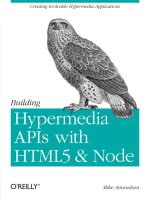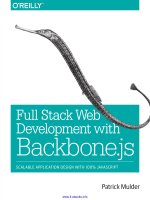building impressive presentations with impress.js
Bạn đang xem bản rút gọn của tài liệu. Xem và tải ngay bản đầy đủ của tài liệu tại đây (2.32 MB, 124 trang )
www.it-ebooks.info
Building Impressive
Presentations with impress.js
Design stunning presentations with dynamic visuals
and 3D transitions that will captivate your colleagues
Rakhitha Nimesh Ratnayake
BIRMINGHAM - MUMBAI
www.it-ebooks.info
Building Impressive Presentations with impress.js
Copyright © 2013 Packt Publishing
All rights reserved. No part of this book may be reproduced, stored in a retrieval
system, or transmitted in any form or by any means, without the prior written
permission of the publisher, except in the case of brief quotations embedded in
critical articles or reviews.
Every effort has been made in the preparation of this book to ensure the accuracy
of the information presented. However, the information contained in this book is
sold without warranty, either express or implied. Neither the author, nor Packt
Publishing, and its dealers and distributors will be held liable for any damages
caused or alleged to be caused directly or indirectly by this book.
Packt Publishing has endeavored to provide trademark information about all of the
companies and products mentioned in this book by the appropriate use of capitals.
However, Packt Publishing cannot guarantee the accuracy of this information.
First published: March 2013
Production Reference: 1190313
Published by Packt Publishing Ltd.
Livery Place
35 Livery Street
Birmingham B3 2PB, UK.
ISBN 978-1-84969-648-7
www.packtpub.com
Cover Image by Duraid Fatouhi ()
www.it-ebooks.info
Credits
Author
Rakhitha Nimesh Ratnayake
Reviewers
Chetankumar Akarte
Christian Ziebarth
Acquisition Editor
Martin Bell
Commissioning Editor
Maria D'souza
Technical Editor
Nitee Shetty
Project Coordinator
Esha Thakker
Proofreader
Maria Gould
Indexer
Tejal Soni
Graphics
Aditi Gajjar
Production Coordinator
Pooja Chiplunkar
Cover Work
Pooja Chiplunkar
www.it-ebooks.info
About the Author
Rakhitha Nimesh Ratnayake is a software engineer working in a leading
software development rm in Sri Lanka. His work there includes planning and
implementing projects in a wide range of technologies based on PHP frameworks.
He is the creator of
www.innovativephp.com, where he writes tutorials on the latest
web development and design technologies. He is also a regular contributor to a
number of popular websites such as 1stwebdesigner, the tuts+ network, and the
Sitepoint network.
He likes to watch cricket and stay with the family when he isn't working on coding
or writing. Make sure to visit him online at
www.innovativephp.com and follow him
on Twitter at twitter.com/innovativephp.
I would like to thank my parents and my brother for providing great
support throughout the book. This was my rst book and I really
appreciate the encouragement they gave in tough periods while
writing the book. Special thanks to Bartek Szopka, who is the creator
of impress.js, for helping me in the early stages of this book.
I would also like to thank Packt team members, Shrutika Kalbag for
nding my article on 1stwebdesigner and providing me with the
idea about this book, Maria D'souza for the support throughout the
book and being the editor, and Esha Thakker for being the project
coordinator of the book.
Finally, I would like to thank you for reading my book and being
one of the most important people who helped me to make this book
a success. Thank you.
www.it-ebooks.info
About the Reviewers
Chetankumar Akarte is an Electronics Engineer from Nagpur University located
in central India. He has more than 6 years of experience in the design, development,
and deployment of Web, Windows, and mobile-based applications with expertise in
PHP, .NET, JavaScript, Java, Android, and more.
He likes to contribute on the newsgroups and forums. He has written articles for
Electronics For You, DeveloperIQ, and Flash & Flex Developer's Magazine. In his
spare time, he likes to maintain his technical blog
to
get in touch with the developers community. He has been the technical reviewer for
three books published by Packt Publishing. He has released some Marathi and Hindi
e-book applications in the Android market ( />apps/developer?id=Sahitya+Chintan
).
He lives in the hilly Kharghar area of Navi Mumbai with his son Kaivalya and wife
Shraddha. You can visit his websites
and http://
www.tipsntracks.com
, or get in touch with him at
I would like to thank my wife Shraddha and my parents for their
consistent support and encouragement and my lovely son Kaivalya
who allowed me to use his playtime with me to dedicate towards
this book. I would also like to thank Packt Publishing for giving me
the opportunity to do something useful and especially the Project
Coordinator, Esha Thakker, for all the valuable support.
www.it-ebooks.info
Christian Ziebarth began working on the Web in 1996 when he was informed
of GeoCities. He began learning HTML in 1998, CSS in 1999, and was doing things
in CSS in Netscape 4 of which only a few people knew could be done at the time.
Since 2000 he has worked on many professional web projects of varying sizes and
continues to explore new frontiers on the Web. He lives in California and has also
lived in Ireland and Hawaii.
www.it-ebooks.info
www.PacktPub.com
Support les, eBooks, discount offers
and more
You might want to visit www.PacktPub.com for support les and downloads related to
your book.
Did you know that Packt offers eBook versions of every book published, with PDF and
ePub les available? You can upgrade to the eBook version at www.PacktPub.com and
as a print book customer, you are entitled to a discount on the eBook copy. Get in touch
with us at for more details.
At www.PacktPub.com, you can also read a collection of free technical articles, sign up
for a range of free newsletters and receive exclusive discounts and offers on Packt books
and eBooks.
Do you need instant solutions to your IT questions? PacktLib is Packt's online digital
book library. Here, you can access, read and search across Packt's entire library of books.
Why Subscribe?
• Fully searchable across every book published by Packt
• Copy and paste, print and bookmark content
• On demand and accessible via web browser
Free Access for Packt account holders
If you have an account with Packt at www.PacktPub.com, you can use this to access
PacktLib today and view nine entirely free books. Simply use your login credentials for
immediate access.
www.it-ebooks.info
www.it-ebooks.info
Table of Contents
Preface 1
Chapter 1: Getting Started with Impressive Presentations 7
What is impress.js? 8
Built-in features 8
Beyond presentations with impress.js 8
Why is it important? 9
Presentation outline 10
Using bullet points 10
Animations 10
Using themes 11
Downloading and conguring impress.js 11
Creating your rst presentation 12
Designing the presentation 13
Creating the presentation container 14
Creating your rst step 14
Applying styles on steps 15
Creating Step 1 16
Creating Step 2 17
Limiting the visibility of steps 18
Presentation overview 19
Summary 20
Chapter 2: Exploring Impress Visualization Effects 21
Introduction to CSS transformations 22
Positioning effects 22
Positioning on the x axis 23
Positioning on the y axis 24
Positioning on the z axis 24
www.it-ebooks.info
Table of Contents
[ ii ]
Rotating effects 26
Rotation around the x axis 26
Rotation around the y axis 27
Rotation around the z axis 28
Rotations in practice 29
Scaling effects 32
The importance of positioning in scaling 34
Scaling in practice 35
Planning the design 35
Data perspective 37
impress.js under the hood 40
Summary 42
Chapter 3: Diving into the Core of impress.js 43
impress.js conguration 44
Default congurations 44
Customizing congurations 45
Conguring the width and height 45
Conguring the minScale and maxScale 46
Conguring the perspective 46
Conguring the transition duration 46
Looking at congurations inside the core 47
Understanding the impress API functions 48
Inside the next function 48
Inside the prev function 49
Inside the goto function 49
Automating presentations 51
Creating custom transition timing 52
impress.js step events 53
How to use the step class 55
Working with keyboard congurations 56
Default keyboard congurations 56
Inside the impress core 56
Assigning custom keys for custom events 58
Adding new keys for new events 58
Handling the step click event 59
Summary 60
Chapter 4: Presenting on Different Viewports 61
Fullscreen presentations 61
Using impress.js inside a container 62
Developing a content slider 62
Planning the design 62
www.it-ebooks.info
Table of Contents
[ iii ]
Designing slides 63
Wrapping the presentation inside a container 64
Playing the slider automatically 64
Creating navigation controls 65
Creating the play/pause features 65
Adding slide numbers 66
Highlighting the active slide 67
impress.js presentations on mobile devices 68
Issues in designing for mobile devices 68
Scenario 1 69
Scenario 2 70
Scenario 3 71
Best design practices for mobiles devices 72
Summary 73
Chapter 5: Creating Personal Websites 75
Planning the website structure 76
Designing the header 76
Creating the presentation wrapper 77
Creating pages 78
Designing the home page 79
Designing the portfolio page 81
Portfolio gallery 81
Portfolio single 82
Designing the timeline page 84
Dening the timeline navigation 86
Designing the services page 87
Handling the navigation menu 89
Creating the navigation hint 90
Summary 91
Chapter 6: Troubleshooting 93
Browser compatibility 93
Handling unsupported browsers 94
Limitations and new features 95
Positioning steps relative to other steps 96
Dening the previous and next steps 96
Transition duration for individual steps 97
Adding and removing navigation keys 97
Creating substeps 97
Troubleshooting and support 98
Summary 99
www.it-ebooks.info
Table of Contents
[ iv ]
Appendix: Impress Tools and Resources 101
Impress presentation tools 101
Strut 101
Impressionist 103
Impressive presentations 104
impress.js demos from the book 104
Index 105
www.it-ebooks.info
Preface
Creating presentations and impressing the audience is an important task for people
who work as software professionals, marketers, public speakers, or anyone who
is familiar with computer-related work. Online presentation creation applications
are gaining much more popularity over conventional desktop-based software
applications in the recent years. impress.js is a powerful library that eases the task
of creating presentations with smooth animations without depending on a software
tool. You are no longer limited to desktop tools as these presentations run on any
supported browser anywhere on the Internet.
This book consists of several practical real-world examples which go beyond the
conventional slide-based presentations covering each aspect of the impress library.
A wide range of applications such as content sliders, image galleries, awesome
presentations, and complete websites are created throughout the book explaining
the techniques in a way that even a beginner can understand.
Understanding how different features work is something we need to know as
developers or designers in order to tweak the core library and create our own
customizations. Important sections of the impress.js core code are explained in detail
with practical examples to make it easier for you to implement new features and
enhance impress.js.
By the time you are done with this book, you'll be able to create a wide range of
components for websites using impress.js as well as stunning visualizations to
impress your audience.
What this book covers
Chapter 1, Getting Started with Impressive Presentations, provides an introduction to
presentations with impress.js and its importance. We also create a basic impress
presentation with detailed code explanations.
www.it-ebooks.info
Preface
[ 2 ]
Chapter 2, Exploring Impress Visualization Effects, discusses the in-depth usage
of impress effects such as positioning, scaling, and rotating using practical
real-world examples. impress.js core code is also discussed in detail to
understand the implementation of CSS effects.
Chapter 3, Diving into the Core of impress.js, is focused on discussing impress.js
congurations and the core code required for simplifying customizations to
existing features. Usage of impress API, step events, and keyboard congurations
is explained using advanced presentations.
Chapter 4, Presenting on Different Viewports, explores the use of impress presentation
fullscreen, inside a container and mobile devices. Fully functional content slider is
created to explain the wide range of uses for impress presentations. Mobile device
support and the handling of presentations on different devices is explained in detail
throughout this chapter.
Chapter 5, Creating Personal Websites, acts as a complete guide to creating personal
websites using impress.js. A single page website is developed with commonly-used
techniques in web design.
Chapter 6, Troubleshooting, covers the compatibility of impress presentations and the
necessary information to x bugs and get support for issues in impress.js. Limitations
and possible future enhancements are explained to motivate you to implement your
own features for impress.js.
Appendix, Impress Tools and Resources, guides you through the available impress.js
presentation automation tools and some awesome presentations available online.
What you need for this book
This book assumes that the readers are familiar with the basics of HTML, CSS, and
JavaScript. Also, you will need the following things in order to work with this book:
• An Internet connection (to load external libraries and fonts in the
demo les)
• Code editor
• impress.js compatible browser
www.it-ebooks.info
Preface
[ 3 ]
Who this book is for
This book is for anyone who is interested in impressing their audience with stunning
online presentations without depending on software applications. The main focus
will be for the web designers and developers who are familiar with technical stuff.
impress.js is a powerful presentation creation library using CSS transforms, so
readers are expected to have the basic HTML, CSS, and JavaScript knowledge for
creating impressive presentations.
Conventions
In this book, you will nd a number of styles of text that distinguish between
different kinds of information. Here are some examples of these styles, and an
explanation of their meaning.
Code words in text, database table names, folder names, lenames, le extensions,
pathnames, dummy URLs, user input, and Twitter handles are shown as follows:
"We can use the
data-rotate-x attribute to rotate elements around the x axis."
A block of code is set as follows:
$(document).ready(function(){
document.addEventListener
("impress:stepenter", function (event) {
// Code for step enter
}, false);
document.addEventListener
("impress:stepleave", function (event) {
// Code for step leave
}, false);
});
When we wish to draw your attention to a particular part of a code block, the
relevant lines or items are set in bold:
$(document).ready(function(){
document.addEventListener
("impress:stepenter", function (event) {
// Code for step enter
}, false);
document.addEventListener
("impress:stepleave", function (event) {
// Code for step leave
}, false);
});
www.it-ebooks.info
Preface
[ 4 ]
New terms and important words are shown in bold. Words that you see on the
screen, in menus or dialog boxes for example, appear in the text like this: "We can
go to the overview of the presentation using the Overview button".
Warnings or important notes appear in a box like this.
Tips and tricks appear like this.
Reader feedback
Feedback from our readers is always welcome. Let us know what you think about
this book—what you liked or may have disliked. Reader feedback is important for us
to develop titles that you really get the most out of.
To send us general feedback, simply send an e-mail to
,
and mention the book title via the subject of your message.
If there is a topic that you have expertise in and you are interested in either writing
or contributing to a book, see our author guide on
www.packtpub.com/authors.
Customer support
Now that you are the proud owner of a Packt book, we have a number of things to
help you to get the most from your purchase.
Downloading the example code
You can download the example code les for all Packt books you have purchased
from your account at . If you purchased this book
elsewhere, you can visit and register to have
the les e-mailed directly to you.
www.it-ebooks.info
Preface
[ 5 ]
Errata
Although we have taken every care to ensure the accuracy of our content, mistakes
do happen. If you nd a mistake in one of our books—maybe a mistake in the text or
the code—we would be grateful if you would report this to us. By doing so, you can
save other readers from frustration and help us improve subsequent versions of this
book. If you nd any errata, please report them by visiting ktpub.
com/submit-errata
, selecting your book, clicking on the errata submission form
link, and entering the details of your errata. Once your errata are veried, your
submission will be accepted and the errata will be uploaded on our website, or
added to any list of existing errata, under the Errata section of that title. Any existing
errata can be viewed by selecting your title from />support
.
Piracy
Piracy of copyright material on the Internet is an ongoing problem across all media.
At Packt, we take the protection of our copyright and licenses very seriously. If you
come across any illegal copies of our works, in any form, on the Internet, please
provide us with the location address or website name immediately so that we can
pursue a remedy.
Please contact us at
with a link to the suspected
pirated material.
We appreciate your help in protecting our authors, and our ability to bring you
valuable content.
Questions
You can contact us at if you are having a problem with
any aspect of the book, and we will do our best to address it.
www.it-ebooks.info
www.it-ebooks.info
Getting Started with
Impressive Presentations
Presentations are one of the most effective ways of communicating our ideas to
people who are interested in the topic. A perfect presentation will grab the attention
of the audience and keep them interested in our ideas, while a bad presentation
can bore our audience and ruin our reputation. This means that, the presentation
creation tools play a vital role in designing a good presentation.
We used to create presentations with popular desktop programs such as Microsoft
PowerPoint and Open Ofce Impress. Things have changed dramatically now and
web-based presentations are gaining more interest from users. impress.js is one
of the stand out frameworks among the web-based presentation creation libraries
and tools. We are going to work on creating impressive visualizations with this
framework from here on.
In this chapter, we are going to cover the following topics:
• What is impress.js?
• Built-in features
• Beyond presentations with impress.js
• Why is it important?
• Downloading and conguring impress.js
• Creating your rst presentation
Ideally you should have basic knowledge of CSS and HTML to understand this
chapter. Everything will be explained using detailed and simple examples and by
the end of this chapter you will have the knowledge to create basic presentation with
impress.js.
So let's get started!
www.it-ebooks.info
Getting Started with Impressive Presentations
[ 8 ]
What is impress.js?
impress.js is a presentation framework build upon the powerful CSS3
transformations and transitions on modern web browsers. Bartek Szopka is the
creator of this amazing framework. According to the creator, the idea came to him
while he was playing with CSS transformations.
Prezi.com was the source that got
him inspired. On
w3.org we have the following mentioned about CSS transforms:
CSS transforms allows elements styled with CSS to be transformed in two-
dimensional or three-dimensional space
For more information on CSS transformations for those who are interested, visit
/>Creating presentations with impress.js is not a difcult task once you get used to the
basics of the framework. Slides in impress.js presentations are called steps and they
go beyond the conventional presentation style. We can have multiple steps visible at
the same time with different dimensions and effects. impress.js step designs are built
upon HTML. This means we can create unlimited effects and the only limitation is
your imagination.
Built-in features
impress.js comes with advanced support for most CSS transformations.
We can combine these features to provide more advanced visualizations in modern
browsers. These features are as follows:
• Positioning: Elements can be placed in certain areas of the browser window
enabling us to move between slides.
• Scaling: Elements can be scaled up or scaled down to show an overview or a
detailed view of elements.
• Rotating: Elements can be rotated across any given axis.
• Working on 3D space: Presentations are not limited to 2D space. All the
previously mentioned effects can be applied to 3D space with the z axis.
Beyond presentations with impress.js
This framework was created to build online presentations with awesome effects
with the power of CSS and JavaScript. Bartek, who is the creator of this framework,
mentions that it has been used for various different purposes expanding the original
intention. Here are some of the most common usages of the impress.js framework:
www.it-ebooks.info
Chapter 1
[ 9 ]
• Creating presentations
• Portfolios
• Sliders
• Single page websites
List of demos containing various types of impress.js presentations can be found at
/>Why is it important?
You must be wondering why we need to care about such a framework when we have
quality presentation programs such as PowerPoint. The most important thing we need
to look at is the license for impress.js. Since it is licensed under MIT and GPL we can
even change the source codes to customize the framework according to our needs.
Also most of the modern browsers support CSS transformations, allowing you to use
impress.js, eliminating the platform dependency of presentation programs.
Both desktop-based presentations and online presentations are equally good at
presenting information to the audience, but online presentations with impress.
js provide a slight advantage over desktop-based presentations in terms of
usability. The following are some of the drawbacks of desktop program generated
presentations, compared to impress.js presentations:
• Desktop presentations require a presentation creation software or
presentation viewer. Therefore, it's difcult to get the same output in
different operating systems.
• Desktop presentations use standard slide-based techniques with a common
template, while impress.js presentation slides can be designed in a wide
range of ways.
• Modications are difcult in desktop-based presentations since it requires
presentation creation software. impress.js presentations can be changed
instantly by modifying the HTML content with a simple text editor.
Creating presentations is not just about lling our slides with a lot of information
and animations. It is a creative process that needs to be planned carefully. Best
practices will tell us that we should keep the slides as simple as possible with very
limited information and, letting presenter do the detailed explanations.
Let's see how we can use impress.js to work with some well-known presentation
design guidelines.
www.it-ebooks.info
Getting Started with Impressive Presentations
[ 10 ]
Presentation outline
The audience does not have any idea about the things you are going to present
prior to the start of the presentation. If your presentation is not up to standard, the
audience will wonder how many boring slides are to come and what the contents
are going to be. Hence, it's better to provide a preliminary slide with the outline of
your presentation.
A limited number of slides and their proper
placement will allow us to create a perfect outline of
the presentation.
Steps in impress.js presentations are placed in 3D space and each slide is positioned
relatively. Generally, we will not have an idea about how slides are placed when the
presentation is on screen. You can zoom in on the steps by using the scaling feature
of impress.js. In this way, we can create additional steps containing the overview of
the presentation by using scaling features.
Using bullet points
People prefer to read the most important points articles rather than huge chunks of
text. It's wise to put these brief points on the slides and let the details come through
your presenting skills. Since impress.js slides are created with HTML, you can easily
use bullet points and various types of designs for them using CSS. You can also create
each point as a separate step allowing you to use different styles for each point.
Animations
We cannot keep the audience interested just by scrolling down the presentation
slides. Presentations need to be interactive and animations are great for getting the
attention of the audience. Generally, we use animations for slide transitions. Even
though presentation tools provide advanced animations, it's our responsibility to
choose the animations wisely.
impress.js provides animation effects for moving, rotating, and scaling step
transitions. We have to make sure it is used with purpose. Explaining the life cycle
of a product or project is an excellent scenario for using rotation animations. So
choose the type of animation that suits your presentation contents and topic.
www.it-ebooks.info
Chapter 1
[ 11 ]
Using themes
Most people like to make the design of their presentation as cool as possible.
Sometimes they get carried away and choose from the best themes available in the
presentation tool. Themes provided by tools are predened and designed to suit
general purposes. Your presentation might be unique and choosing an existing
theme can ruin the uniqueness. The best practice is to create your own themes for
your presentations.
impress.js does not come with built-in themes. Hence there is no other option than to
create a new theme from scratch. impress.js steps are different to each other unlike
standard presentations, so you have the freedom to create a theme or design for each
of the steps just by using some simple HTML and CSS code.
Apart from the previous points, we can use typography, images, and videos to create
better designs for impress.js presentations. We have covered the background and the
importance for impress.js. Now we can move on to creating real presentations using
the framework throughout the next few sections.
Downloading and conguring impress.js
You can obtain a copy of the impress.js library by downloading from the github page
at The downloaded .zip le contains
an example demo and necessary styles in addition to the impress.js le. Extract
the .zip le on to your hard drive and load the index.html on the browser to see
impress.js in action. The folder structure of the downloaded .zip le is as given in
the following screenshot:
www.it-ebooks.info
Getting Started with Impressive Presentations
[ 12 ]
Conguring impress.js is something you should be able to do quite easily. I'll walk you
through the conguration process. First we have to include the impress.js le in the
HTML le. It is recommended you load this le as late as possible in your document.
Create a basic HTML le called chapter1.html and place the following code:
<!doctype html>
<html lang="en">
<head>
<title>impress.js </title>
</head>
<body>
<script src="js/impress.js"></script>
</body>
</html>
Downloading the example code
You can download the example code les for all Packt books
you have purchased from your account at http://www.
packtpub.com. If you purchased this book elsewhere, you can
visit and register to
have the les e-mailed directly to you.
We have linked the impress.js le just before the closing body tag to make sure it is
loaded after all the elements in our document. Then we need to initialize the impress
library to make the presentations work.
We can place the following code after the
impress.js le to initialize any existing
presentation in the document which is compatible with the impress library:
<script>impress().init();</script>
Since we have done the setup of the impress.js library, we can move on to creating
our rst impressive presentation.
Creating your rst presentation
You might be familiar with creating presentations with software tools that provides
a slide-by-slide view. Presenting on a web browser is completely different from
standard slideshows. We have an innite space to position the slides in web-based
presentations where as we get slide after slide in software-based presentations.
Unless we plan the design of the presentations slides in a creative way, we are going
have problems using presentations with impress.js.
www.it-ebooks.info









